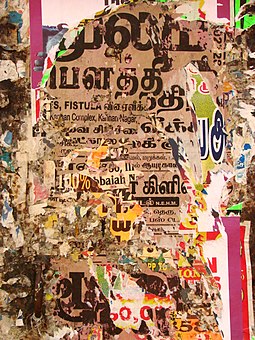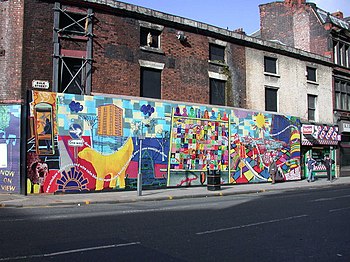
Street side handbills, Puducherry
This category contains the many products and images we are exposed to every day. In the industrialized world, this includes posters, graffiti, advertising, popular music, television and digital imagery, magazines, books, and movies (as distinguished from film, which we’ll examine in a different context later in the course). Also included are cars, celebrity status, and all the ideas and attitudes that help define the contemporary period of a particular culture.

Public mural, Liverpool
Handbills posted on telephone poles or the sides of buildings are graphic, colourful, and informative, but they also provide a street level texture to the urban environment most of us live in. Public murals serve this same function. They put an aesthetic stamp on an otherwise bland and industrialized landscape.
Introduction
Visual arts are generally divided into categories that make distinctions based on the context of the work. For example, Leonardo da Vinci’s Mona Lisa does not fall into the same category as, say, a poster for a rock concert. Some artworks can be placed in more than one category.
During the time of the Italian Renaissance, c. 1500, painting was considered the equal of great poetry or literature as they both could affect human conduct (“ut pictura poesis”). These works were highly praised and collected and displayed in great museums like the Louvre (Paris) and the National Gallery (London). These paintings had an attained a certain pedigree and were often called “old masters” or fine art. The museum paintings had a definite finish to them and revealed subjects of a serious nature, often based on literature. When the French Impressionists began painting pictures of the countryside, without stories and of a sketchy appearance, these work were not allowed for exhibition in the Louvre. The paintings had to be displayed in private galleries as pictures of everyday life or popular culture. A third type of art appeared in the late 19th-century where designers like William Morris in England began designing items for the mass market such as decorative wall papers. This applied or decorative art flourish under the Art Nouveau banner, but had various names c. 1900 and after.
Fine art
This category includes drawings, paintings, sculptures, photographs, and, in the last decade, new media that are in museum collections and sold through commercial art galleries. Fine art has a distinction of being some of the finest examples of our human artistic heritage. Here is where you will find the Mona Lisa, and ancient sculpture, such as the Gandhara figure from India (see the following image), and stunning ceramics from different cultures and time periods.
Leonardo Da Vinci, Mona Lisa, c. 1503-1519. Oil on poplar, 30″ x 21″; The Louvre, Paris
Stucco Ganhara figure, India, 4th–5th century CE; Victoria & Albert Museum, London
Blue and white vase, Jingdezhen Ming Yongle, 1403-1424
Popular culture
This category contains the many products and images we are exposed to every day. In the industrialized world, this includes posters, graffiti, advertising, popular music, television and digital imagery, magazines, books, and movies (as distinguished from film, which we’ll examine in a different context later in the course). Also included are cars, celebrity status, and all the ideas and attitudes that help define the contemporary period of a particular culture.
Handbills posted on telephone poles or the sides of buildings are graphic, colourful, and informative, but they also provide a street level texture to the urban environment most of us live in. Public murals serve this same function. They put an aesthetic stamp on an otherwise bland and industrialized landscape.
Decorative arts, or crafts
Sometimes called crafts, this is a category of art that shows a high degree of skilled workmanship in its production. Crafts are normally associated with utilitarian purposes but can be aesthetic works in themselves, often highly decorated. This Mexican ceramic vessel is an example. Handmade furniture and glassware, fine metalworking, and leather goods are examples of crafts.
Analyze a Work of Art
Using the course Art Resources and/or any art links or resources of your choice, find a work of art from any culture or time period and use it to answer the following questions:
Content is available under the
Creative Commons Attribution Share Alike License.
Privacy Policy | Authors